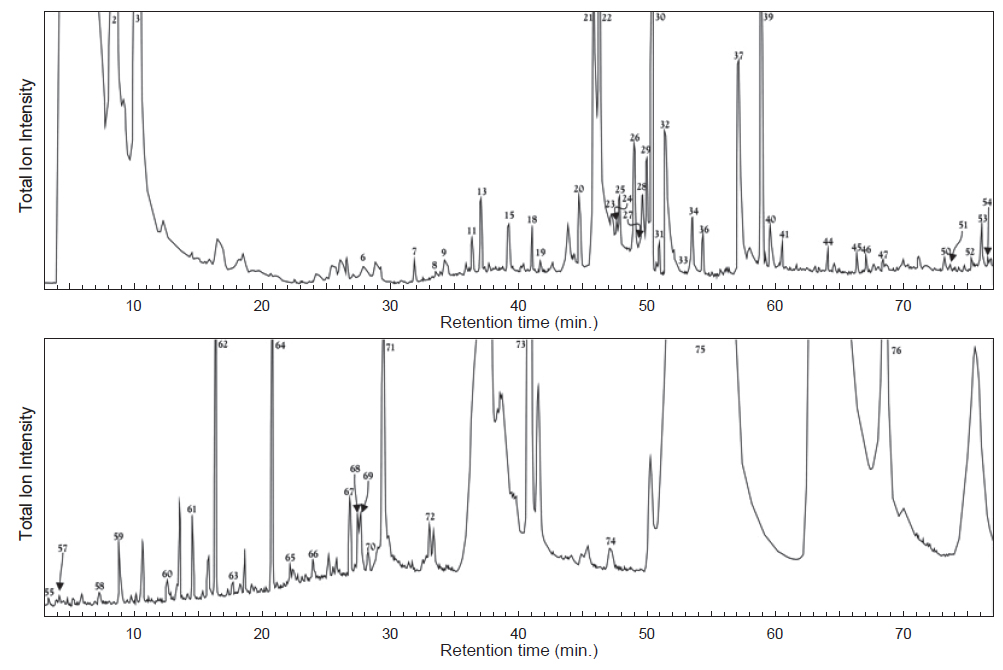



굴(
재료로 사용한 IQF 굴(
각종 부원료 즉, 설탕 15%, 식염 6.0%, MSG 4.0%, 간장 4.0%, 전분 3.5%, 효모 추출물 3.0% 및 소맥분 3.5%를 물 21.0%와 잘 혼합한 후 여기에 reaction flavoring을 통해 풍미를 개선시킨 IQF 굴 복합엑스분(Brix 30°) 40.0%를 첨가하여 90-95℃에서 20분간 잘 저어주면서 가열하였다. 다음 이를 가열된 상태에서 유리병에 일정량씩 충전 밀봉하여 95℃에서 40분간 열탕살균한 후 상온에 저장하면서 향기성분 분석용 시료로 사용하였다. 굴 소스의 부원료 조성과 proportioning 비율은 요리전문가의 자문과 예비 관능시험을 통하여 결정하였다.
일반성분의 조성은 상법(KSFSN, 2000a)에 따라 수분함량은 상압가열건조법, 조단백질 함량은 semi-micro Kjeldahl법, 조회분 함량은 건식회화법으로 측정하였다. pH는 시료를 균질화한 다음 pH meter (Accumet Basic, Fisher Sci Co., USA)로 측정하였고, 염도(salinity)는 염도계(460CP, Istek Co., Korea)로 측정하였다. 휘발성염기질소(volatile basic nitrogen, VBN)는 Conway unit를 사용하는 미량확산법(KSFSN, 2000b)으로 측정하였다.
가열향기 성분의 추출 및 포집
가열향기 성분의 추출은 굴 소스 시작품 300 mL를 1 L 용량의 추출용기에 넣고, 추출용매로서 재증류한 diethyl ether를 사용하여 Lickens-Nickerson형 simultaneous steam distillation and solvent extraction (SDE) 장치로 상압 하에서 3시간 동안 증류, 추출하였다. 이 추출액을 -20℃에서 하룻밤 방치하여 얼음층을 제거하고, Kuderna-Danish 농축장치로 농축한 다음 무수 망초를 가하여 탈수하였다. 이를 일정량으로 재농축하여 가열향기성분 분석용 SDE 추출액으로 하였다.
GC, GC/MS 분석 및 동정
GC : SDE 추출액 3 μL를 Supelcowax-10 capillary column (50 m×0.25 mm, 0.25 μm film thickness, Sigma-Aldrich Co. LLC., Germany)이 장착된 HP 5890 GC (Hewlett-Packard Co., USA)에 SDE 추출액 3 μL를 주입하여 분석하였고, 분석조건은 전보(Kang et al., 2010)와 같다.
GC/MS : GC와 동일한 Supelcowax-10 capillary column이 장착된 HP 5890A GC/5970 MS (Hewlett-Packard Co., USA)에 주입하여 splitless mode로 분석하였고, 분석조건은 전보(Kang et al., 2010)와 같다. 휘발성 성분은 분리된 화합물의 mass spectrum을 standard MS library database인 Wiley 138 (Hewlett-Packard Co.)에 의해 search하여 relative similarity가 85% 이상인 화합물에 대하여 동일물질로서 유의성을 인정하였다.
굴 소스 시작품의 일반성분, pH, 염도 및 VBN 함량은 Table 1과 같다. 굴 소스 시작품의 수분함량은 60.6%, 조단백질 8.2%, 조회분 9.2%, pH는 5.7, 염도는 9.3, 그리고 VBN 함량은 21.0 mg/100 g이었다.

Proximate composition, pH, salinity and volatile basic nitrogen (VBN) contents of the oyster sauce prepared from IQF oyster Crassostrea gigas
SDE 장치를 이용하여 굴 소스 시작품의 가열향기 성분을 추출한 후 이를 GC 및 GC/MS로 분석한 휘발성 성분의 total ion chromatogram을 Fig. 1에, 휘발성 성분의 group별 조성과 함량을 Table 2에 나타내었다.
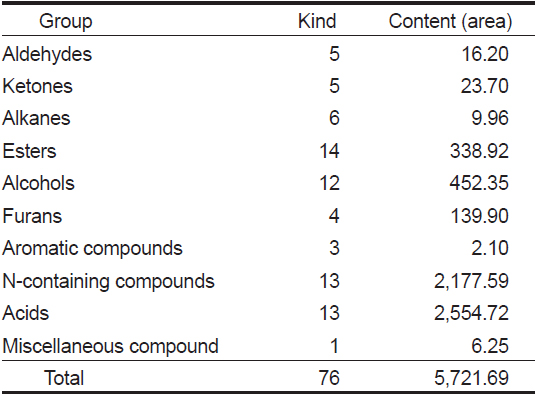
Number and content of each volatile flavor components groups identified from the cooked oyster Crassostrea gigassauce by simultaneous steam distillation-solvent extraction
굴 소스 시작품의 가열향기 성분으로 총 76성분이 동정되었으며, 이들 성분을 group별로 분류하면 aldehyde류 5종, ketone류 5종, alkane류 6종, ester류 14종, alcohol류 12종, furan류 4종, aromatic compound류 3종, N-containing compound류 13종, acid류 13종 및 miscellaneous compound류 1종으로 구성되어 있었고, 계수적인 측면에서 가장 많은 종류의 화합물은 ester 류, N-containing compound류, acid류 및 alcohol류 순이었다. 함량 면에서는 TIC 상의 area 기준으로 acid류가 2,554.72로 가장 많았으며, 다음이 N-containing compound류 2,177.59, acohol류 452.35, ester 류 338.92 순이었다.
굴 소스 시작품의 가열향기 성분 중 동정된 휘발성 aldehyde류, ketone류 및 alkane류의 조성은 Table 3과 같다. 굴 가열향기 중 동정된 aldehyde류로는 octanal, benzaldehyde 등 5종이 동정되었으며, 그 중 benzaldehyde가 양적으로 비교적 많이 함유되어 있었다. 이 aldehyde류들은 주로 고도불포화지방산의 산화분해에 의해 생성된 것으로 보인다. 1-octen-3-one 등 5종이 동정된 ketone 화합물은 1-(2-furanyl)-ethanone이 양적으로 가장 많이 함유되어 있었다. 이들 카르보닐 화합물은 대부분 고도불포화지방산의 산화분해물로 특징적인 냄새보다는 굴 소스 가열향기의 감미있는 달콤한 냄새 발현에 기여할 것으로 보인다(Cha et al., 1992). Tetradecane, pentadecane 등 6종이 동정된 alkane 화합물은 타 휘발성 group에 비하여 양적으로 적었으며, 또한 대부분이 역치가 높은 성분들로 굴 소스 가열향기의 발현에는 크게 관여하지 않을 것으로 생각된다.
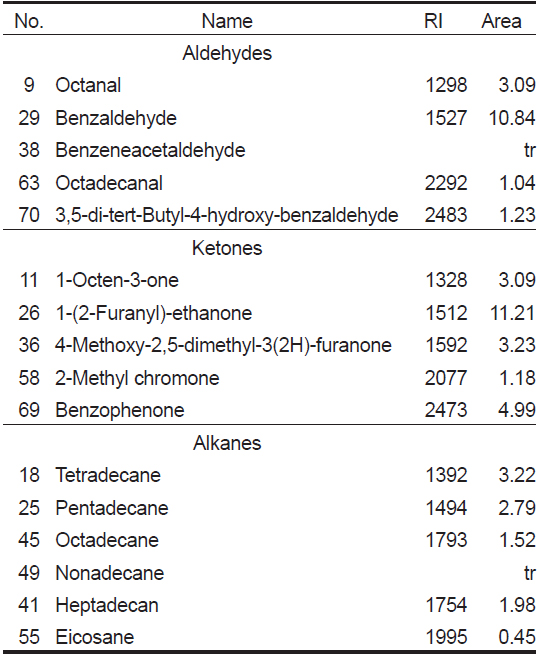
Aldehydes, ketones and alkanes identified from the volatile components of the cooked oyster Crassostrea gigas sauce
굴 소스 시작품의 가열향기 성분 중 동정된 ester류 및 aromatic compound류 의 조성은 Table 4와 같다. 과일향과 유사한 냄새로 알려진 ester 화합물로서는 ethyl acetate 등 14종이 동정되었으며, aromatic compound류로는 d-limonene 등 3종이 검출되었으나 타 group에 비해 양적으로 미량이었다.
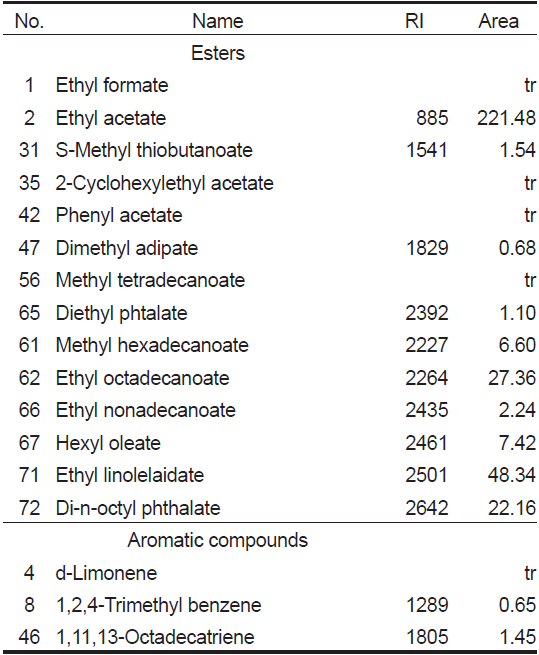
Esters and aromatic compounds identified from the volatile components of the cooked oyster Crassostrea gigas sauce
굴 소스 시작품의 가열향기 성분 중 동정된 휘발성 alcohol류와 furan류의 조성은 Table 5와 같다. Ethyl alcohol 등 12종이 동정된 alcohol류 중에서 ethyl alcohol과 6-methyl heptanol 등이 가장 함량이 많았으며, 나머지는 미량이었다. 일반적으로 alcohol류는 지방산의 2차적 분해산물로서(Moga and Sizer, 1973) 높은 역치를 가지기 때문에 많은 양이 존재하지 않는 한 식품의 향기에 크게 영향을 미치지 않는다고 알려져 있다(Cha and Cadwallader, 1995). 따라서 본 alcohol류는 그 함량 및 종류로 보아 굴 소스 가열향기의 특징적인 냄새보다는 일반적인 은은하고 달콤한 냄새를 부여할 것으로 보인다(Heath and Reineccius, 1986). 자숙 중 Maillard 반응에 의해 유도 생성되는 은은한 aroma 계통 화합물인 furan 화합물은 2-acetylfurane 등 4종이 검출되었으며, 2-furancarboxaldehyde와 2-furanmethanol이 양적으로 많았다.
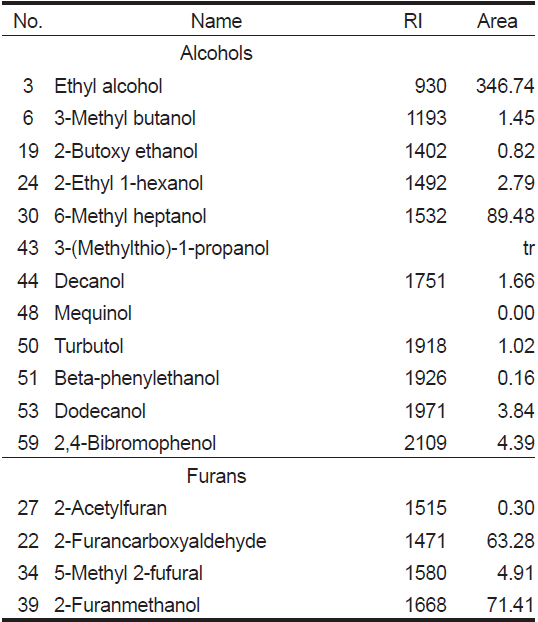
Alcohols, furans and miscellaneous compound identified from the volatile components of the cooked oyster Crassostrea gigas sauce
굴 소스 가열향기 성분 중 동정된 휘발성 N-containing compounds와 휘발성 acid 류의 조성은 Table 6과 같다. Pyrazine, methyl-pyrazine, pyrrole, 2,4,6-trimethyl pyridine 및 3-Ethyl 2,5-dimethyl pyrazine 등을 위주로 한 N-containing compound류는 모두 13종이 검출되었고, 2,4,6-trimethyl pyridine이 양적으로 가장 많이 함유되어 있었다. 본 실험에서 검출된 pyrazine류는 일반적으로 대부분의 식품에 고소한 향, 볶은 향, 알몬드향을 부여하며, 새우 및 가재와 같은 갑각류의 주요한 냄새성분으로 알려져 있다. 이러한 heterocyclic 화합물은 가열하는 동안 Maillard 반응에 의해 형성되며, 가열식품에서는 많이 검출되는 대표적인 화합물이다(Moga and Sizer, 1973; Cha and Cadwallader, 1995; Kusaka et al., 1983). Pyridine류는 다소 불쾌한 냄새를 가지며(Moga and Sizer, 1973), 이 N-containing compounds류들은 주로 Strecker 분해를 통한 Maillard 반응이나 pyrolysis 반응에 의해 생성된다고 보고되어 있다(Ho and Carlin, 1989). N-containing compound류는 그 관능적 특성 및 낮은 역치(Shibamoto and Bernhard, 1976) 등을 고려할 때 이들은 계수적으로나 양적으로 보아 굴 소스 가열향기의 특징적인 냄새발현에 주요한 역할을 할 것으로 생각된다.
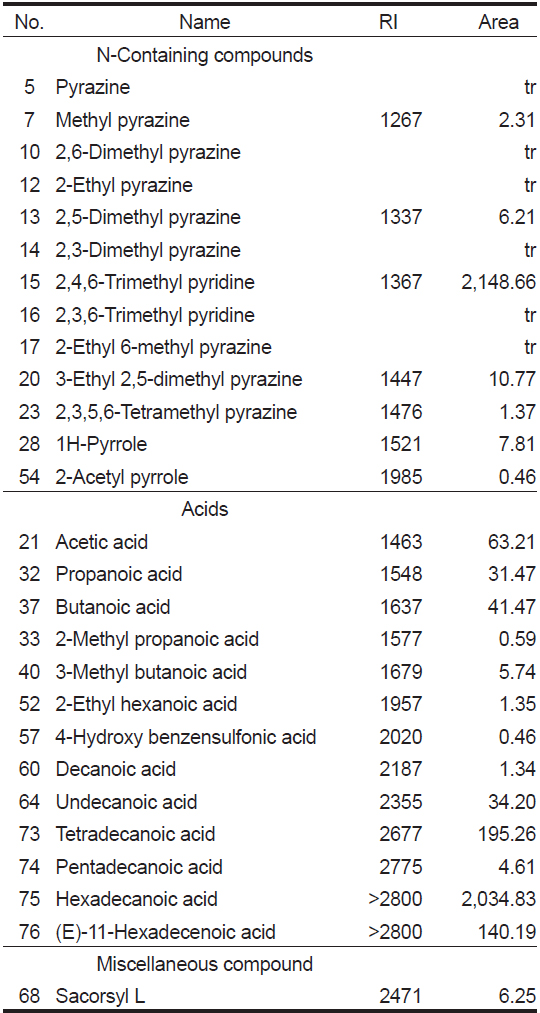
Nitrogen-containing compounds and acids identified from the volatile components of the cooked oyster Crassostrea gigas sauce
Acetic acid 등 13종이 동정된 휘발성 acid류는 타 화합물에 비해 양적으로 월등히 많이 함유되어 있었는데, hexadecanoic acid 및 tetradecanoic acid가 양적으로 타 acid류에 비해 월등히 많았다. 이들 휘발성 acid류는 종류에 따라서 다소 불쾌한 자극적인 냄새 혹은 상쾌한 과실향을 내는 것으로 알려져 있다. 한편, 함황 화합물의 경우 역치가 낮아 적은 양으로도 식품의 특징적인 냄새발현에 영향을 미치며, 대체로 탄내나 양이 미량일 경우 고소한 냄새를 내는데 본 굴 소스의 가열향기 성분에서는 발견되지 않았다.

